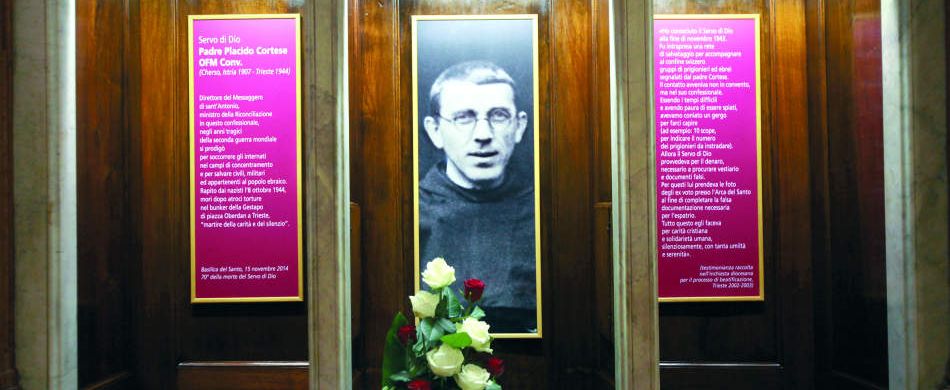THERE IS a place in the Basilica of Saint Anthony in Padua that is particularly dear to me. It is Fr. Placido Cortese’s confessional. This is actually a wooden niche located just behind the presbytery, almost in front of the entrance to the Chapel of Relics. A photo of Fr. Placido hangs inside of it, flanked by two posters which recall his deeds, courage and selflessness. I pass by it almost every day because, even though he died before I was born, I feel a special bond to him. He is a dear friend and, whenever I have a problem connected with my work as the executive editor of this magazine, I seek his heavenly aid and advice. After all, he was the General Director of the Messenger of Saint Anthony during the Second World War.
During those difficult years Fr. Placido not only managed to keep our magazine circulating, but at the same time, on the personal request of the Pontifical Delegate, he secretly organized rescue missions for Jews, British prisoners of war, Yugoslavs, Czechs and others fleeing Nazi persecution. Fr. Pacido set up a secret network of lay collaborators which he ran from his confessional in the Basilica. Pretending to go there to confess themselves, these people used coded language to communicate their real requests. For instance, “I need five eggs” actually meant that five people needed money and ID cards to get into Switzerland, or “We need three kilos of flour” meant that three people needed to find refuge in Padua, etc. Thanks to the Messenger’s printing presses it was not hard for Fr. Placido and his lay collaborators to produce fake passports, ID cards or permits for those desperate people.
This arrangement worked quite well for a while, and the Franciscan friar was able to save hundreds of people. The Germans, however, eventually got wind of this organization, and gradually understood that Fr. Placido was its leader. Despite knowing that he was under their radar, the friar went on undeterred in his selfless service until he was finally arrested on 8 October 1944. On that day, a man he believed to be a loyal collaborator called him from the entrance of the friary. With the pretext of needing to save a group of refugees, the man asked Fr. Pacido to accompany him to his car parked in front of the Basilica, but that car actually belonged to the Gestapo.
Fr. Placido was taken to the port city of Trieste where he was subjected to a series of harsh interrogations and terrible tortures, but he was able to endure this hideous ordeal without revealing the names of his collaborators. According to the sworn evidence of Vladimir Vouhnik, a Slovenian colonel, “The Gestapo gouged out the eyes and cut off the tongue of friar Placido Cortese, and then buried him alive.”
Fr. Placido died at the Gestapo bunker in Piazza Oberdan in Trieste in November 1944 at the age of 37. His body was later burned in the crematorium of the Risiera di San Sabba, a rice-husking facility which the Nazis had transformed into a transit/prison camp and extermination site, as well as a storehouse for valuables seized from their victims. Many Jews and Nazi opponents were tortured and executed there and their bodies were burned in the crematorium. In this way Fr. Placido’s ashes were mixed with those of many victims of the Holocaust, the genocide against which he had fought strenuously, and from which he had managed to save hundreds of lives. The cause for his beatification was opened in 2002 and is presently pending.
Holocaust Memorial Day takes place on 27 January each year. It is a time for everyone to pause and remember the millions of people who perished or whose lives were drastically changed, not only during the Shoah, but also during the more recent genocides that took place in Cambodia, Rwanda, Bosnia and Darfur.
On that day we should learn the lessons of the past and recognize that a genocide does not just take place on its own, but that it is a steady and degenerative process which begins when discrimination, racism and hatred are not checked and prevented.
During his visit to the Great Synagogue of Rome on 17 January last year, Pope Francis said, “The Jewish people, in their history, were subjected to violence and persecution, culminating in the extermination of Jews in Europe during the Shoah… The past must serve as a lesson for us in the present and the future. The Shoah teaches us to always maintain the highest level of vigilance, in order to be able to intervene immediately in defense of human dignity and peace.”




